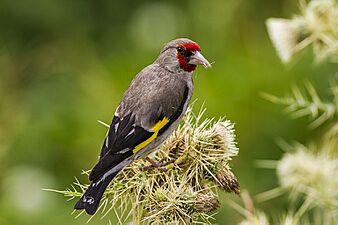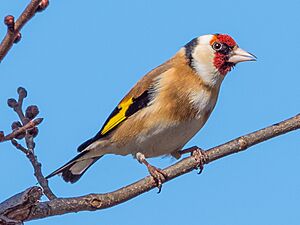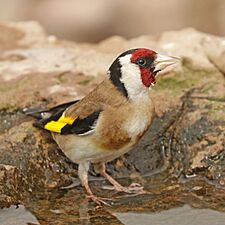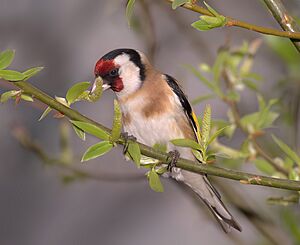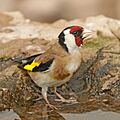European goldfinch facts for kids
Quick facts for kids European goldfinch |
|
|---|---|
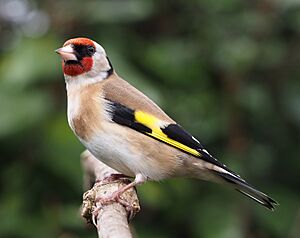 |
|
| C. c. britannica in Wigan, UK | |
| Conservation status | |
| Scientific classification | |
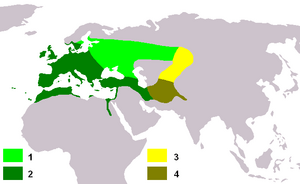 |
|
| Carduelis carduelis carduelis 1 summer 2 all year Carduelis carduelis caniceps 3 summer 4 all year |
|
| Synonyms | |
|
Fringilla carduelis Linnaeus, 1758 |
The European goldfinch, often just called the goldfinch (its scientific name is Carduelis carduelis), is a small songbird. It belongs to the finch family. This bird is originally from Europe, North Africa, and parts of Asia. It has also been brought to other places like Australia, New Zealand, and Uruguay.
Male and female goldfinches look quite similar. The male has a bright red face with black marks around its eyes. Its head is black and white. The back and sides are a warm brown color. Its black wings have a wide, bright yellow stripe. The tail is black, and its rump (the area above the tail) is white. Females have a slightly smaller red area on their face.
Goldfinches are often seen in old Italian Renaissance paintings, especially those showing the Madonna and Child.
Contents
About the Goldfinch Name
The European goldfinch was first described by a Swiss scientist named Conrad Gessner in 1555. Later, in 1758, Carl Linnaeus gave it its official two-part scientific name, Fringilla carduelis. The word Carduelis is Latin for 'goldfinch'. Today, the European goldfinch is part of the Carduelis group of birds.
Scientists have studied the genes of these birds. They found that the European goldfinch is closely related to the citril finch and the Corsican finch.
The English word 'goldfinch' has been used for a long time. The famous writer Geoffrey Chaucer used it in his story The Cook's Tale back in the 1300s. He wrote about someone being "gaily dressed as is a goldfinch in the woods."
Goldfinch Types
European goldfinches have different types, called subspecies. These are grouped into two main kinds. They can mix where their homes meet, even though they look different.
- The carduelis group lives in the western parts of their range. These birds have black crowns on their heads.
- The caniceps group lives in the eastern parts. These birds have grey heads instead of black.
-
C. c. caniceps
Found in Himachal Pradesh, India -
C. c. carduelis
Found in Sweden -
C. c. niediecki
Found in Cyprus -
C. c. parva
Found in Algeria
How Goldfinches Look
A European goldfinch is usually about 12 to 13 centimeters (5 inches) long. Its wingspan, which is how wide its wings are when spread out, is about 21 to 25 centimeters (8 to 10 inches). It weighs about 14 to 19 grams (0.5 to 0.7 ounces).
Both male and female goldfinches have a red face and a black and white head. Their upper parts are warm brown, and their undersides are white with buff patches. Their wings are black and yellow.
If you look closely, you can often tell males from females. Males usually have a larger, darker red mask that goes a bit behind their eye. Their shoulder feathers are black, while females have brown shoulder feathers. The female's red face does not go past her eye.
The goldfinch's bill (beak) is long and pointed, and it's an ivory color. Its tail is forked, meaning it splits into two points. When goldfinches are ready to breed, their bill is white. The rest of the year, it has a grayish or blackish tip.
Young goldfinches, called juveniles, have a plain head and a grayer back. But you can still easily spot them because of their bright yellow wing stripe. Goldfinches in central Asia (the caniceps group) have a plain grey head behind their red face. They don't have the black and white head pattern seen in European goldfinches.
Goldfinches change their feathers after the breeding season. This process is called molting. After molting, their colors might look a bit duller until the tips of their new feathers wear off.
The song of a goldfinch is a lovely, silvery sound. Their call is a melodic "tickeLIT." Their song is a pleasant mix of trills and twitters.
Where Goldfinches Live
The European goldfinch is originally from Europe, North Africa, and parts of Asia. They like to live in open areas with some trees. In warmer western regions, they stay all year round. But in colder places, they migrate to warmer areas for winter. They might also move locally to avoid bad weather, even in the west.
These birds have been brought to many other parts of the world. In the 1800s, they were introduced to places like Bermuda, Canada, the United States, Mexico, Peru, Argentina, Chile, Uruguay, Brazil, South Africa, Australia, and New Zealand. Their numbers quickly grew, and they spread widely. In Australia, they are now found from Brisbane to the Eyre Peninsula. They are also common throughout New Zealand. In the United States, they have made homes in the western Great Lakes area.
Goldfinch Life and Habits
Nesting and Reproduction
The female goldfinch builds the nest all by herself, usually in about a week. The male stays with her but doesn't help build. The nest is neat and strong. It's often placed several meters (many feet) off the ground, hidden by leaves at the end of a swaying branch.
The nest is made of mosses and lichens. It's lined with soft plant fluff, like from thistles. The female uses spider silk to attach the nest to the tree twigs. The nest is shaped like a deep cup, which helps keep the eggs safe in windy weather.
The female lays her eggs in the early morning, one egg each day. A typical nest has 4 to 6 eggs. They are whitish with reddish-brown speckles. The eggs are smooth and slightly shiny. Each egg is about 17.3 x 13.0 millimeters (0.7 x 0.5 inches) and weighs about 1.53 grams (0.05 ounces).
The female sits on the eggs to keep them warm for 11 to 13 days. During this time, the male brings her food. Once the chicks hatch, both parents feed them. At first, the chicks eat a mix of seeds and insects. As they grow, they eat fewer insects and more seeds. The female keeps the young chicks warm for the first 7 to 9 days. The young birds leave the nest 13 to 18 days after hatching. Both parents continue to feed them for another 7 to 9 days. Goldfinch parents usually raise two groups of chicks each year, and sometimes even three.
What Goldfinches Eat
European goldfinches love to eat small seeds. They especially like seeds from thistles, cornflowers, and teasels. In fact, their Latin name comes from Carduus, which is a type of thistle. When they are feeding their young, they also eat insects.
In winter, goldfinches often visit birdfeeders. They group together in flocks of up to 40 birds, sometimes even more. Many people in Europe and North America attract goldfinches to their back gardens by offering niger seeds. These small, oily seeds come from a plant that grows in Africa. Special feeders with small oval openings are sometimes used, which are perfect for goldfinches to feed from.
Goldfinches and People
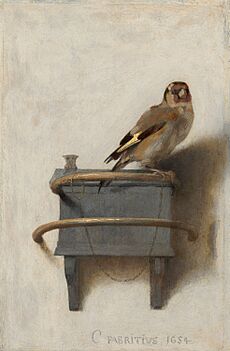
People around the world often keep goldfinches as pets. They are liked for their unique look and pleasant song. However, if goldfinches are kept with canaries, they might start to sing like canaries instead of their natural goldfinch song. This is usually not wanted by people who keep them.
In Great Britain during the 1800s, many thousands of goldfinches were caught each year to be sold as cage birds. The Royal Society for the Protection of Birds started one of its first campaigns to stop this trade. Today, conservation efforts try to limit bird trapping and protect the open spaces where goldfinches live.
The German city of Berlin has a part called Steglitz, which is named after the European goldfinch. Also, the last name Goldspink comes from the Scots word for this bird.
Goldfinches in Christian Art
In Christian art, the European goldfinch is often linked to Christ's suffering and his crown of thorns. This is because it eats thistle seeds. When a goldfinch appears in paintings of the Madonna and Christ child, it often means that Jesus and Mary knew about the Crucifixion beforehand.
For example, in the painting Madonna of the Goldfinch by Raphael, John the Baptist offers a goldfinch to Christ. This is seen as a warning about Jesus's future. In another painting, Holy Family by Federico Barocci, John the Baptist holds a goldfinch high, away from a curious cat. In Cima da Conegliano's Madonna and Child, a goldfinch flutters in the hand of the Christ child. The goldfinch also stands for strength, fruitfulness, and not giving up. Because it symbolizes suffering, the goldfinch is sometimes seen as a "savior" bird. It might even be shown with a common housefly, which represents sin or sickness. The goldfinch is also connected to Saint Jerome and appears in some pictures of him.
Goldfinches in Other Art
The composer Antonio Vivaldi wrote a flute concerto called "Il Gardellino" (The Goldfinch). In this music, the flute imitates the singing of the goldfinch. An old Italian poem called Il Cardellino was set to music by Saverio Mercadante and sung by famous singer Jose Carreras.
Goldfinches are also mentioned in poems. In John Keats' poem 'I stood tip-toe upon a little hill...' (1816), goldfinches with their "yellow flutterings" are among the many beautiful things in nature that make the speaker happy.
In the poem The Great Hunger by Patrick Kavanagh, the goldfinch is one of the few beautiful sights in the life of an old Irish farmer:
The goldfinches on the railway paling were worth looking at
A man might imagine then
Himself in Brazil and these birds the birds of paradise
The novel The Goldfinch by Donna Tartt won a major award in 2014. A key moment in the story happens when the main character, Theo, sees his mother's favorite painting, Carel Fabritius's The Goldfinch, at a museum.
Images for kids
-
C. c. britannica in Wigan, UK
-
C. c. caniceps
Himachal Pradesh, India -
C. c. carduelis
Sweden -
C. c. niediecki
Cyprus -
C. c. parva
Algeria -
Madonna of the Goldfinch by Raphael, c. 1505–6
-
The Goldfinch by Carel Fabritius, 1654



